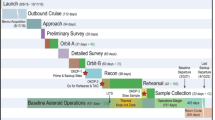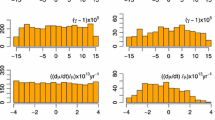Abstract
We used more than 250 000 high-precision American and Russian radar observations of the inner planets and spacecraft obtained in the period 1961–2003 to test the relativistic parameters and to estimate the solar oblateness. Our analysis of the observations was based on the EPM ephemerides of the Institute of Applied Astronomy, Russian Academy of Sciences, constructed by the simultaneous numerical integration of the equations of motion for the nine major planets, the Sun, and the Moon in the post-Newtonian approximation. The gravitational noise introduced by asteroids into the orbits of the inner planets was reduced significantly by including 301 large asteroids and the perturbations from the massive ring of small asteroids in the simultaneous integration of the equations of motion. Since the post-Newtonian parameters and the solar oblateness produce various secular and periodic effects in the orbital elements of all planets, these were estimated from the simultaneous solution: the post-Newtonian parameters are β = 1.0000 ± 0.0001 and γ = 0.9999 ± 0.0002, the gravitational quadrupole moment of the Sun is J 2 = (1.9 ± 0.3) × 10−7, and the variation of the gravitational constant is Ġ/G = (−2 ± 5) × 10−14 yr−1. The results obtained show a remarkable correspondence of the planetary motions and the propagation of light to General Relativity and narrow significantly the range of possible values for alternative theories of gravitation.
Similar content being viewed by others
References
E. I. Afanasieva, M. D. Kislik, Yu. F. Kolyuka, and V. F. Tikhonov, Astron. Zh. 67, 1326 (1990) [Sov. Astron. 34, 670 (1990)].
J. D. Anderson, J. K. Campbell, R. F. Jurgens, et al., 6th Marcel Grossman Meeting on General Relativity, Ed. by H. Sato and T. Nakamura (World Sci., 1992), p. 353.
J. D. Anderson, P. B. Esposito, W. Martin, et al., Astrophys. J. 200, 221 (1975).
J. D. Anderson, M. S. Keesey, E. L. Lau, et al., Acta Astronautica 5, 43 (1978).
J. D. Anderson, E. L. Lau, S. Turyshev, et al., Bull. Am. Astron. Soc. 34, 660 (2002).
B. Bertotti, L. Iess, and P. Tortora, Nature 425, 374 (2003).
T. M. Brown, J. Christensen-Dalsgaad, W. A. Dziembowski, et al., Astrophys. J. 343, 526 (1989).
V. A. Brumberg, Relativistic Celestial Mechanics (Nauka, Moscow, 1972).
V. A. Brumberg and E. Groten, Astron. Astrophys. 367, 1070 (2001).
V. M. Canuto, S.-H. Hsieh, and J. R. Owen, Mon. Not. R. Astron. Soc. 188, 829 (1979).
T. Damour and J. H. Taylor, Astrophys. J. 366, 501 (1991).
T. L. Duvall, W. A. Dziembowski, P. Goode, et al., Nature 310, 22 (1984).
T. M. Eubanks, D. N. Matsakis, J. O. Martin, et al., American Physical Society APS/AAPT Joint Meeting (1997).
M. Froeschle, F. Mignard, and F. Arenou, Hipparcos—Venice 97, ESA-402 (Venice, 1997), p. 49.
S. Godier and J. P. Rozelot, Astron. Astrophys. 355, 365 (2000).
R. W. Hellings, P. J. Adams, J. D. Anderson, et al., Phys. Rev. Lett. 51, 1609 (1983).
R. W. Hellings, P. J. Adams, J. D. Anderson, et al., Int. J. Theor. Phys. 28, 1035 (1989).
H. A. Hill, R. J. Bos, and P. R. Goode, Phys. Rev. Lett. 49, 1794 (1982).
G. A. Krasinsky, Commun. of IAA RAS 148, 1 (2002).
G. A. Krasinsky, E. V. Pitjeva, M. V. Vasilyev, and E. I. Yagudina, Commun. of IAA RAS 139, 1 (2001).
G. A. Krasinsky, E. V. Pitjeva, M. V. Vasilyev, and E. I. Yagudina, Icarus 158, 98 (2002).
D. E. Lebach, B. E. Corey, I. I. Shapiro, et al., Phys. Rev. Lett. 75, 1439 (1995).
X. X. Newhall, E. M. Standish, Jr., and J. G. Williams, Astron. Astrophys. 125, 150 (1983).
L. Paterno, S. Sofia, and M. P. Di Mauro, Astron. Astrophys. 314, 940 (1996).
F. P. Pijpers, Mon. Not. R. Astron. Soc. 297, L76 (1998).
S. Pireaux and J.-P. Rozelot, Astrophys. Space Sci. 284, 1159 (2003).
E. V. Pitjeva, Byull. Inst. T. A., Ross. Akad. Nauk 15, 538 (1986).
E. V. Pitjeva, Celest. Mech. 55, 333 (1993).
E. V. Pitjeva, Third International Workshop on Position Astronomy and Celestial Mechanics, Ed. by G. A. Lopez, E. I. Yagudina, U. M. Martinez, and B. A. Condero (Observ. Astron. Univ. Valencia, 1996), p. 583.
E. V. Pitjeva, Tr. Inst. P. A., Ross. Akad. Nauk 4, 22 (1999).
E. V. Pitjeva, Tr. Inst. P. A., Ross. Akad. Nauk 5, 58 (2000).
E. V. Pitjeva, Celest. Mech. 80, 249 (2001).
E. V. Pitjeva, Tr. Inst. P. A., Ross. Akad. Nauk 10, 112 (2004).
E. V. Pitjeva, Transit of Venus: New Views of the Solar System and Galaxy, IAU Coll. 196, Ed. by D. W. Kurtz (Cambridge University Press, 2005).
R. D. Reasenberg and I. I. Shapiro, On the Measurement of Cosmological Variations of the Gravitational Constant, Ed. by L. Halpern (Florida Univ. Press, USA, 1978), p. 71.
R. D. Reasenberg, I. I. Shapiro, P. E. MacNeil, et al., Astrophys. J. 234, L219 (1979).
D. S. Robertson, W. E. Carter, and W. H. Dillinger, Nature 349, 768 (1991).
I. I. Shapiro, G. H. Pettengill, M. E. Ash, et al., Phys. Rev. Lett. 28, 1594 (1972).
I. I. Shapiro, G. H. Pettengill, M. E. Ash, et al., Phys. Rev. Lett. 20, 1265 (1968).
E. M. Standish, Bull. Am. Astron. Soc. 32, 870 (2000).
E. M. Standish, Astron. Astrophys. 233, 252 (1990).
E. M. Standish, Astron. Astrophys. 336, 381 (1998).
E. M. Standish and A. Fienga, Astron. Astrophys. 384, 322 (2002).
J. G. Williams, D. H. Boggs, J. O. Dickey, and W. M. Folkner, Ninth Marcel Grossman Meeting, Ed. by V. G. Gurzadyan, R. T. Jantzen, and R. Ruffini (World Sci., 2002), p. 1797.
Author information
Authors and Affiliations
Additional information
__________
Translated from Pis’ma v Astronomicheski\(\overset{\lower0.5em\hbox{$\smash{\scriptscriptstyle\smile}$}}{l} \) Zhurnal, Vol. 31, No. 5, 2005, pp. 378–387.
Original Russian Text Copyright © 2005 by Pitjeva.
Rights and permissions
About this article
Cite this article
Pitjeva, E.V. Relativistic effects and solar oblateness from radar observations of planets and spacecraft. Astron. Lett. 31, 340–349 (2005). https://doi.org/10.1134/1.1922533
Received:
Issue Date:
DOI: https://doi.org/10.1134/1.1922533




